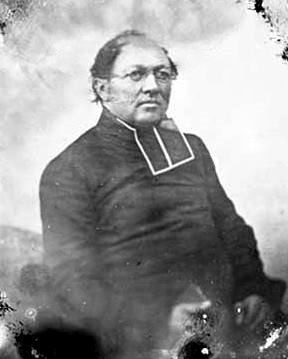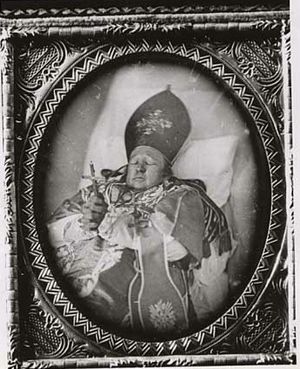Joseph Crétin facts for kids
Joseph Crétin (born 1799 – died 1857) was an important leader in the Roman Catholic Church. He became the very first Bishop of Saint Paul, Minnesota. You can find places named after him in St. Paul, like Cretin Avenue, Cretin-Derham Hall High School, and Cretin Hall at the University of St. Thomas.
Contents
Life Story
Joseph Crétin was born in Montluel, France, on December 19, 1799. He studied to become a priest in different schools in France. He was officially made a priest on December 20, 1823.
Early Work in France
After becoming a priest, Crétin worked in a town called Ferney. He became the main priest there. He helped build a new church and started a boys' school. He raised money for these projects by traveling around France. He also helped people in his area become more interested in the Catholic faith again.
Becoming a Missionary
Crétin wanted to do more. He thought about becoming a missionary in China. But then, his old friend, Bishop Mathias Loras, came to France. Bishop Loras was the first bishop of Dubuque, Iowa, in America. He was looking for priests to help in his large area.
Crétin decided to volunteer. On August 16, 1838, he secretly left his church. He sailed from France with Bishop Loras and arrived in New York in October.
Work in America
Crétin spent the winter of 1838-1839 in St. Louis, Missouri. He arrived in Dubuque, Iowa, on April 18, 1839. He was quickly made a "vicar-general," which meant he was a main helper to the bishop.
For over eleven years, he worked as a priest in this new region. He spent time in Dubuque, Prairie du Chien, Wisconsin, and with the Winnebago Indians near Fort Atkinson. In 1847, he took a trip back to Europe to get help for his missions.
First Bishop of St. Paul
In 1850, St. Paul, Minnesota, became the center of a new church area called a diocese. Joseph Crétin was chosen to be its first bishop. He went to France to be "consecrated" (a special ceremony to become a bishop) on January 26, 1851.
At that time, his diocese was huge! It included all of Minnesota and the Dakotas. He got some money and more priests for his new diocese. He then returned to America, arriving in St. Paul on July 2, 1851. That evening, he gave his first blessing to the people in the small log chapel, which was his first cathedral.
Building the Church in Minnesota
Bishop Crétin worked very hard to build up the church in St. Paul.
- In less than five months, a large brick building was finished. It was used as a school, a home, and a second cathedral.
- Another big church building was started in 1855. It was finished after he died. This building served as the main cathedral until the current Cathedral was built in 1915.
- In 1853, a hospital was built.
- He bought land for cemeteries in 1853 and 1856.
Education and Community
Bishop Crétin also cared a lot about education.
- In 1851, he brought a group of nuns called the Sisters of St. Joseph to teach children.
- In 1855, he brought the Brothers of the Holy Family to help with teaching too.
- He planned to build a "seminary," which is a school for people who want to become priests. He even kept some students preparing for the priesthood at his own home.
He also supported "temperance," which means avoiding alcohol. In January 1852, he started the Catholic Temperance Society of St. Paul. This was the first group of its kind in Minnesota.
Helping Immigrants
Another important project for Bishop Crétin was helping Catholic families move to Minnesota. He wanted to bring immigrants from European countries to the rich farmlands of Minnesota. He knew this would help his diocese grow in the future.
Even with all these projects, he still traveled a lot. He visited people throughout his huge diocese, offering comfort and religious services.
Joseph Crétin died in St. Paul, Minnesota, on February 22, 1857. Many people, especially the older residents of St. Paul, remember him with great respect.



